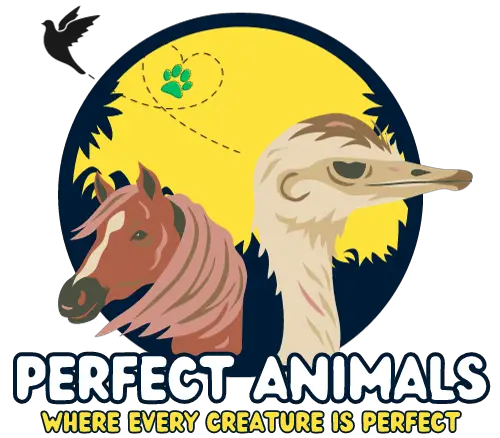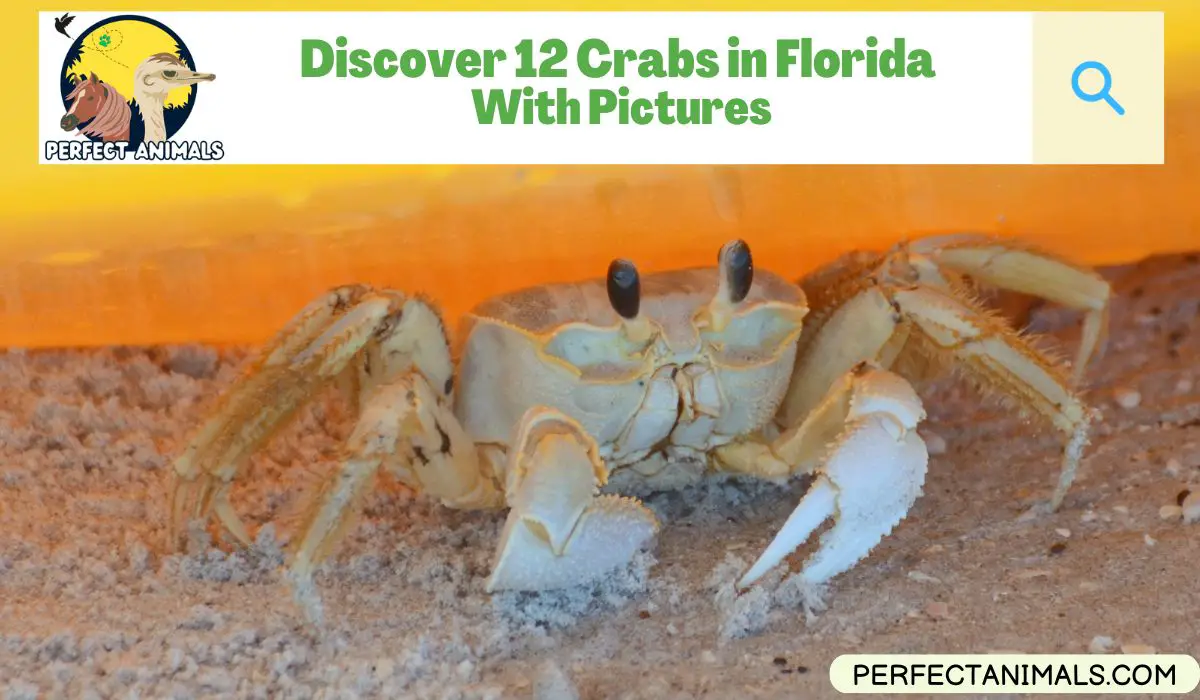With over 4,000 miles of coastline, it’s no wonder that Florida is home to a variety of crab species.
From succulent stone crab claws to tiny fiddler crabs scuttling along the beach, crabs are ubiquitous in Florida’s coastal ecosystems.
Whether you’re a seafood lover or simply fascinated by these ten-legged crustaceans, crabs are an iconic part of the Florida experience.
In this article, we’ll explore some of the most common crabs in Florida. We’ll learn about the different types of edible and inedible crabs, where they can be found, and tips for responsibly catching your own crabs for an authentic Florida feast.
With blue crab season and stone crab season attracting seafood lovers from far and wide, there’s never been a better time to learn about Florida’s wealth of spectacular crabs. So let’s get cracking!
Do You Need a License to Crab in Florida?
Part of responsibly catching crabs in Florida involves following proper licensing protocols.
While you may envision yourself trapping crabs recreationally using just some bait and a net, there are actually regulations in place for recreational crab fishing.
The Florida Fish and Wildlife Conservation Commission (FWC) requires all recreational crabbers aged 16 and older to complete a no-cost blue crab trap registration before setting any traps.
This registration system allows the FWC to collect data on recreational crab harvests to inform future management decisions.
To get your recreational trap registration, you’ll need to set up an account on the FWC’s licensing platform Go to Myfwc.com
There you can add the free Recreational Blue Crab Trap Registration to your account profile.
With your registration, you’ll be given unique identifying numbers that must be displayed on each trap along with your name and address.
Following proper licensing protocols is key for ethical and sustainable recreational crabbing in Florida.
And with the quick online registration process, it’s easy for anyone eager to get out on the water and try their hand at trapping delicious blue crabs!
You May Also Like – Can Crabs Swim?
Types of Crabs in Florida
Blue Crab
No discussion of Florida crabs is complete without mentioning the iconic blue crab.
With their vivid blue claws and shells, these feisty crustaceans are a staple of Florida’s coastal cuisine and ecosystems.
In the Sunshine State, blue crabs flourish in the brackish estuaries and lagoons lining the Atlantic and Gulf coasts.
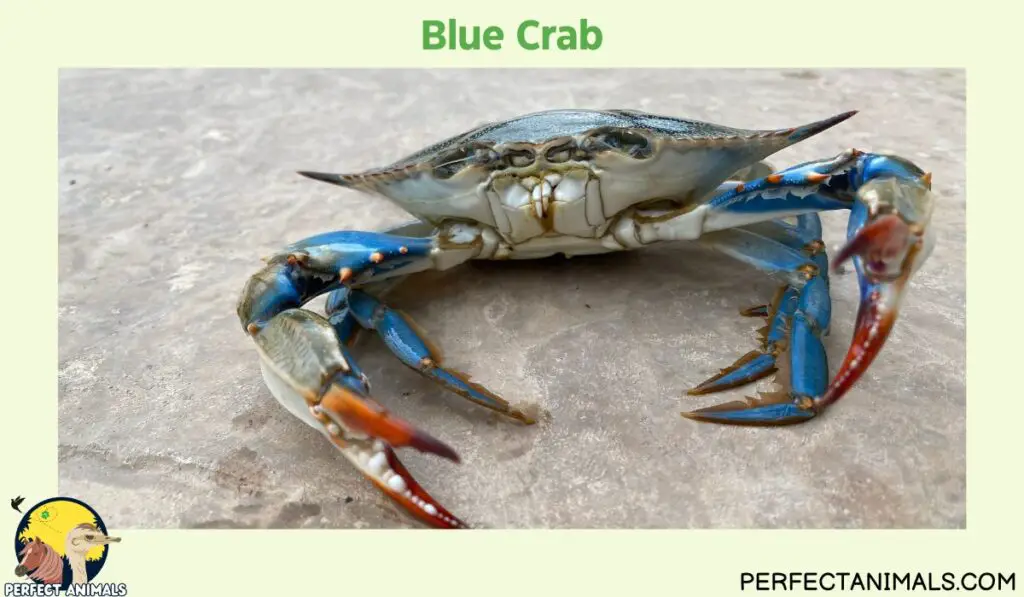
Males grow up to 9 inches wide, while females reach a slightly smaller size.
They’ll eat just about anything – clams, smaller crabs, fish, plants – and in turn fall prey to larger fish, birds, and reptiles.
Blue crab populations have faced declines in some areas due to habitat loss and overfishing.
But they remain a vital part of Florida’s coastal food web and a favorite for recreational and commercial crabbers alike.
Their sweet, delicate meat is the star of many Florida seafood classics like crab cakes and she-crab soup.
Stone Crab
Florida is also famous for its tasty stone crabs. Ranging along both Gulf and Atlantic shores, these stocky crabs have two unequally sized pincers perfect for cracking open oysters and mollusks.
Their name comes from their camouflaging gray-brown shell that blends into the seabed.
Stone crabs thrive around Florida’s jetties and rocky reefs.

Only their large claws are harvested by fishermen, who then return the crabs to grow new claws.
Claws are categorized by size for sale, from medium to colossal.
Connoisseurs love the tender, lobster-like claw meat, especially served chilled with mustard sauce.
Sustainably fished stone crab claws are a quintessential Florida delicacy.
Their unique fishery and incredible flavor make these crabs one of the state’s most iconic local seafoods.
You May Also Like – Do Sea Turtles Drink Water?
Golden Crab
While most crabs stick to shallow coastal waters, the golden crab inhabits the dark depths of Florida’s continental shelf.
These hefty crustaceans, weighing up to 5 pounds, make their homes up to 2,000 feet down in the Gulf of Mexico and Atlantic.
Their creamy golden-orange shells shine like treasure in the light.
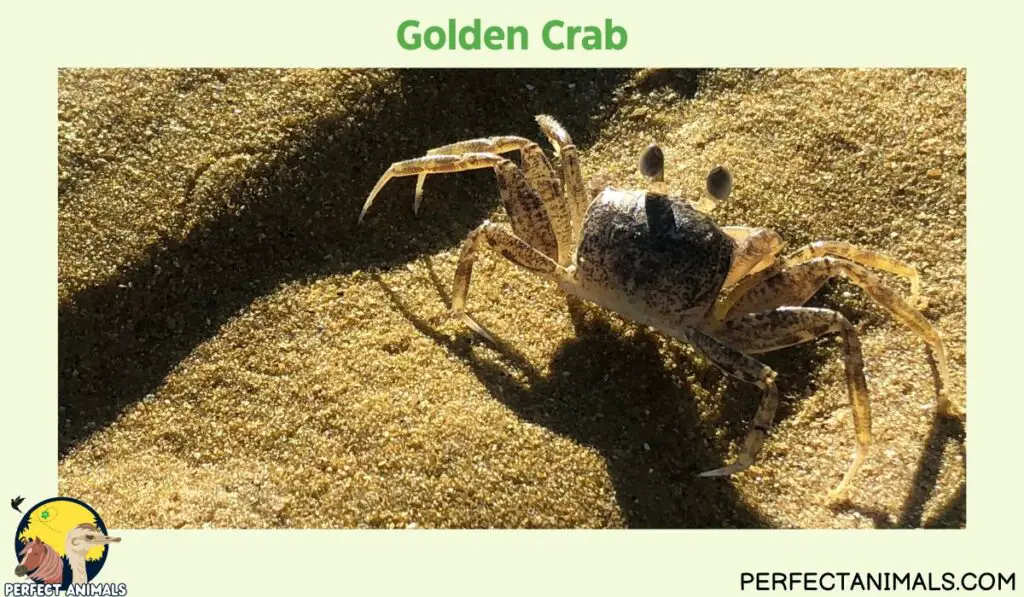
To catch these elusive crabs, fishermen lower large wire traps called “condos” to the seafloor for days at a time.
It’s dangerous work in the pitch black depths. But the sweet, delicate meat of the golden crab makes it worthwhile.
The texture and flavor work well in everything from crab cakes to creamy bisques.
Golden crabs represent one of Florida’s most exotic and unique commercial fisheries.
While most will never gaze upon one alive, golden crab is increasingly popular on menus, letting landlocked diners sample the treasures of Florida’s deep seas.
These rare golden crustaceans are a reminder that even far offshore, Florida’s waters teem with amazing diversity.
Fiddler Crab
One of the smallest and most abundant crabs along Florida shorelines is the fiddler crab.
These tiny crabs, named for the dramatically enlarged claws of males, thrive in the intertidal zones of beaches, mudflats, and marshes.
Pea-sized fiddler crabs sift through wet sand for algae and decaying plants to eat.
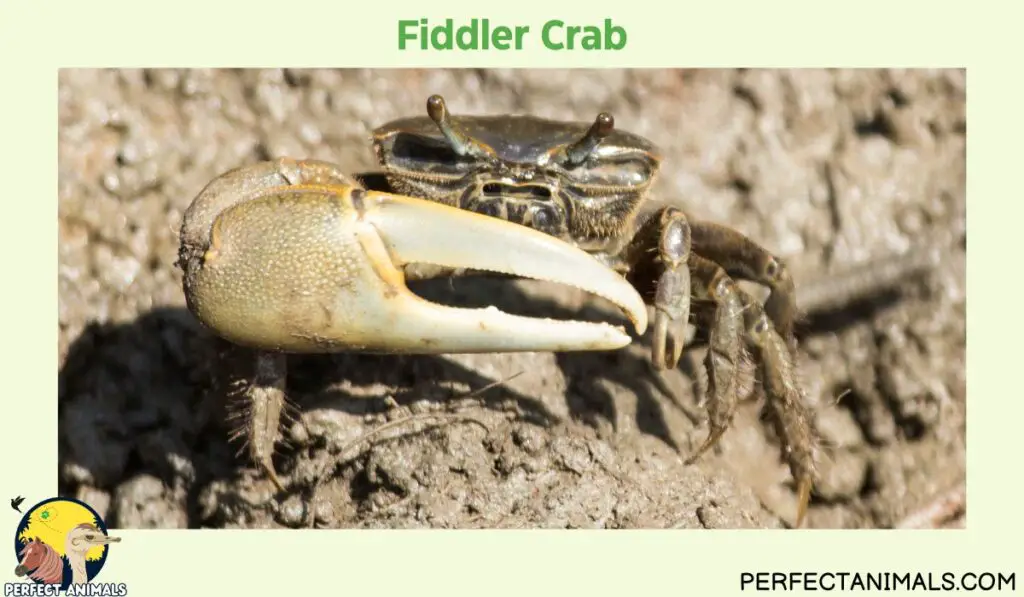
Males diligently maintain sandy burrows for mating and shelter, waving their oversized claws to attract females.
After mating, females timed with spring tides release larvae that float far offshore, eventually drifting back to colonize new marshlands.
Though diminutive, fiddler crabs play an integral role in Florida’s coastal ecosystems.
Their burrows aerate marsh sediment while their feeding aerates puddles and substrate.
They provide a vital food source for shorebirds and fish.
Numerous as they are, fiddler crabs are a key part of the diversity and productivity of Florida’s iconic coastal habitats.
You May Also Like – Do Barracudas Eat Fish Eggs?
Jonah Crab
Found in deeper waters along Florida’s Atlantic coast is the Jonah crab, a larger cousin of the rock crab.
Named for the biblical prophet, these brownish crabs with black-tipped claws can grow over 9 inches wide.
Jonah crabs live on rocky and sandy bottoms from the intertidal zone down to depths of 800 meters.
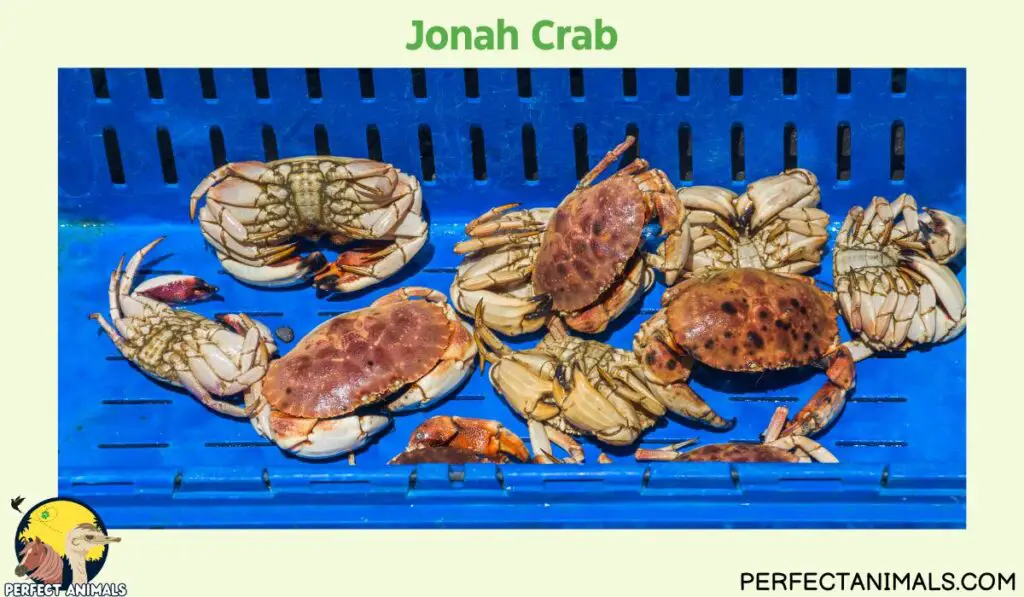
Here they dine on mussels, snails, and algae. While slow-moving, they can deliver a painful pinch with their robust claws.
In Florida, Jonah crabs are most abundant offshore during winter and early spring.
Females move inshore during summer to release larvae. Their affinity for cooler waters allows year-round harvesting.
Jonah’s crab meat is tender, sweet, and similar to that of a king crab.
Though not as pricey as other crabs, Jonah crab is growing in popularity for its great taste and sustainability.
It’s an excellent choice for crab cakes, sandwiches, and more – giving seafood lovers another delicious way to enjoy Florida’s bountiful ocean harvests.
Hermit Crab
One of the most charismatic crabs found in Florida is the hermit crab.
As their name suggests, these small crabs are known for seeking solitude in empty seashells for protection.
But they are actually quite social, traveling in large groups and interacting frequently.
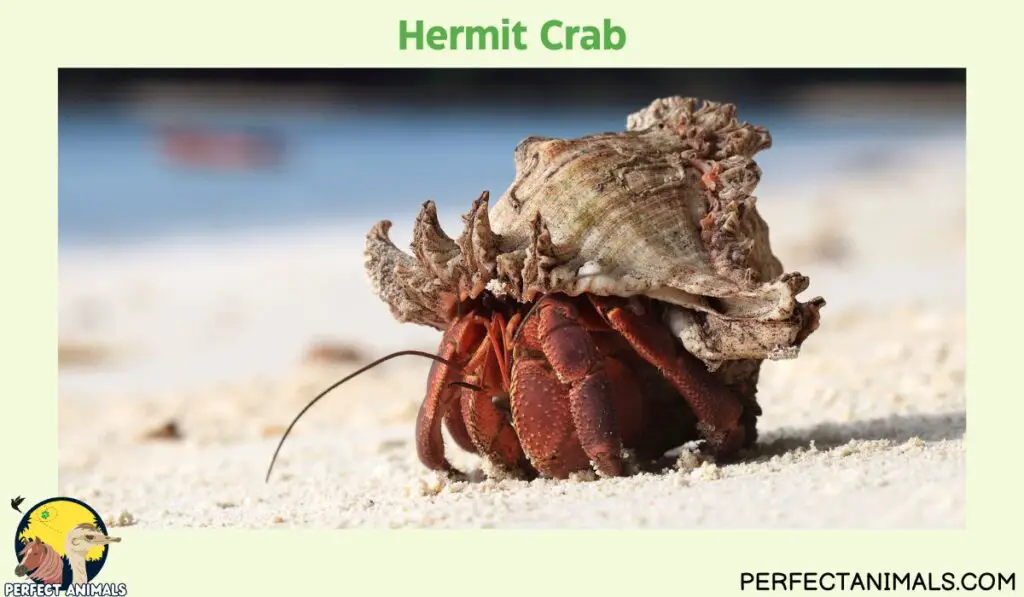
Various hermit crab species inhabit Florida’s sandy and muddy coastal bottoms.
To shelter their soft abdomens, they borrow abandoned shells, moving into larger homes as they grow.
Hermit crabs use their slender legs and claws to scavenge for food bits on the seabed.
Watching hermit crabs scuttle around in their mobile shelters is an amusing pastime for beachgoers in Florida.
Next time you find an unoccupied shell, turn it over and chances are a tiny hermit will go scooting out.
Though reclusive by nature, hermit crabs are a fun and lively addition to Florida’s coastal biodiversity.
You May Also Like – Do Pufferfish Have Teeth?
Spider Crab
One of the more bizarre-looking crabs found in Florida’s waters is the aptly named spider crab.
These spindly crustaceans have a rounded shell and extremely long, slender legs spanning over a foot in mature specimens.
Their legs are covered in algae, sponges, and other growth, disguising them as floating debris.
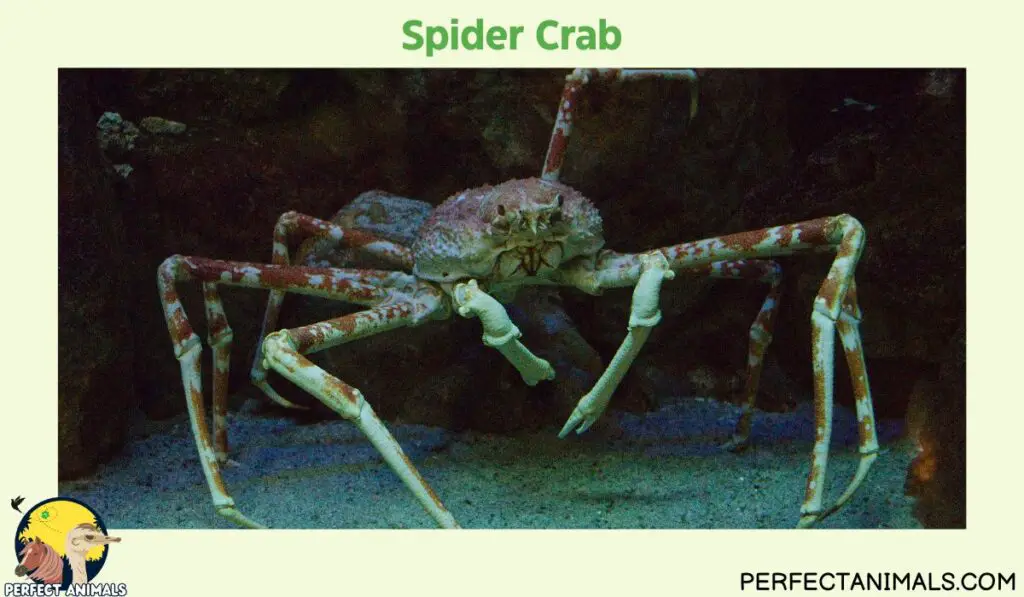
Spider crabs use their many legs to scuttle across the sandy and muddy sea floor, scavenging for bits of plants and animals to eat.
While not considered commercially valuable, they are sometimes caught as bycatch by Florida fishermen.
Though not the gigantic Japanese spider crab, Florida’s native species make for an intimidating and alien sight with their spidery physique.
Spider crab legs were once pulled from the ocean and sold as “crab’s claws” before their true identity was known.
Today, spotting a camouflaged spider crab is a unique treat for divers and beachcombers exploring Florida’s coasts.
Atlantic Ghost Crab
One of the most fascinating crabs prowling Florida beaches is the aptly named ghost crab.
These aptly named crabs blend into the sand with their square, semi-transparent carapaces reaching up to 3 inches wide.
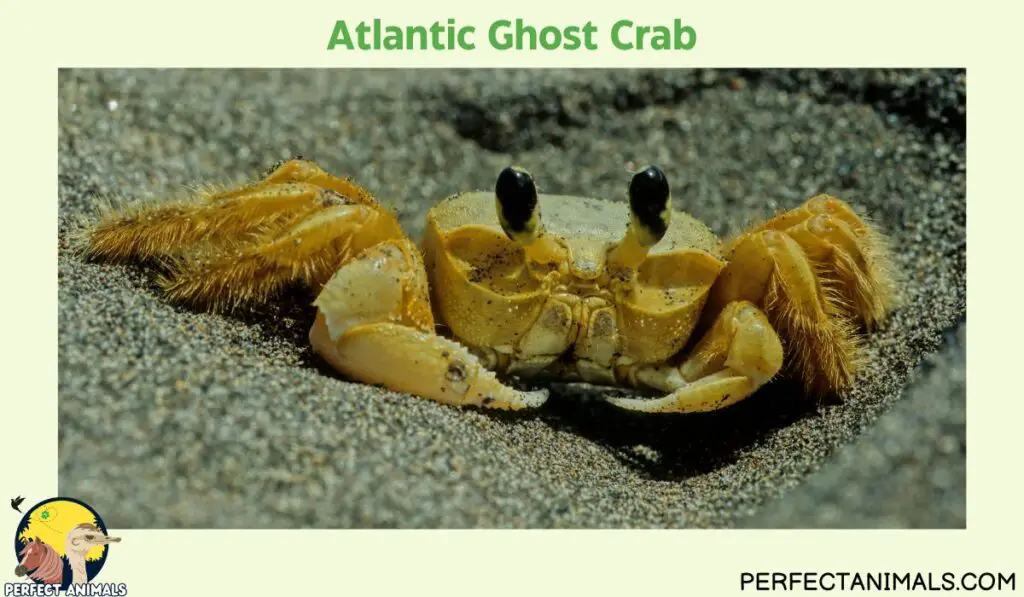
The crabs dig burrows above the high tide line where they spend the day, emerging at night to feed.
Ghost crabs use their uncanny camouflage to avoid shorebird predators.
They can also dart back into their burrows or flatten into the sand when threatened.
Though the crabs are omnivores, they will opportunistically eat turtle eggs and hatchlings stranded on the beach.
Watching ghost crabs skitter across the dimly lit sand is a magical experience on Florida beaches at night.
The way they disappear against the sandy backdrop is a remarkable example of adaptations at work.
You May Also Like – Turtles Without Shells
Bocourt Swimming Crab
The Bocourt swimming crab is a species originating from the Caribbean that has become an invasive resident of Florida’s waters.
Named for their swimming technique of paddling with their rear legs, these small crabs have light brown shells with vivid red spotting.
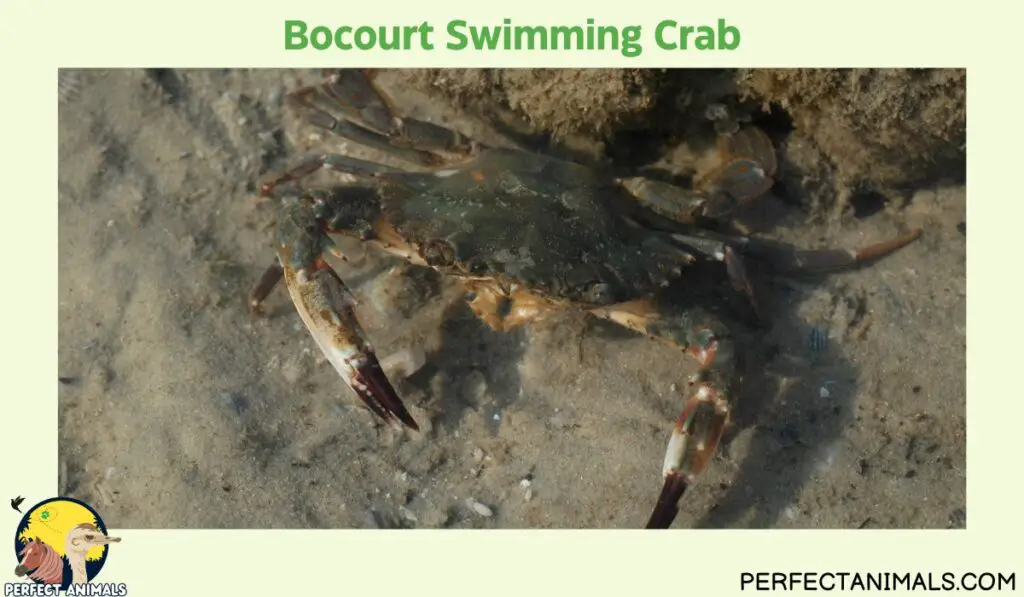
In Florida, Bocourt swimming crabs can be found all along the Atlantic coastline.
They inhabit estuaries and nearshore waters, where they scavenge and feed on plant matter.
Considered less commercially viable than blue crabs, they are sometimes caught as bycatch by crabbers in Florida.
As an introduced species, the ecological impacts of the Bocourt swimming crab in Florida are still being studied.
But their presence is a testament to the state’s diverse mingling of Caribbean and Atlantic species, old residents and new arrivals alike.
Mangrove Tree Crab
An iconic sight in Florida’s mangrove forests is the mangrove tree crab.
True to their name, these tiny crabs live amongst the muddy roots and canopy of mangroves.
Their mottled green coloration provides camouflage against the leaves.
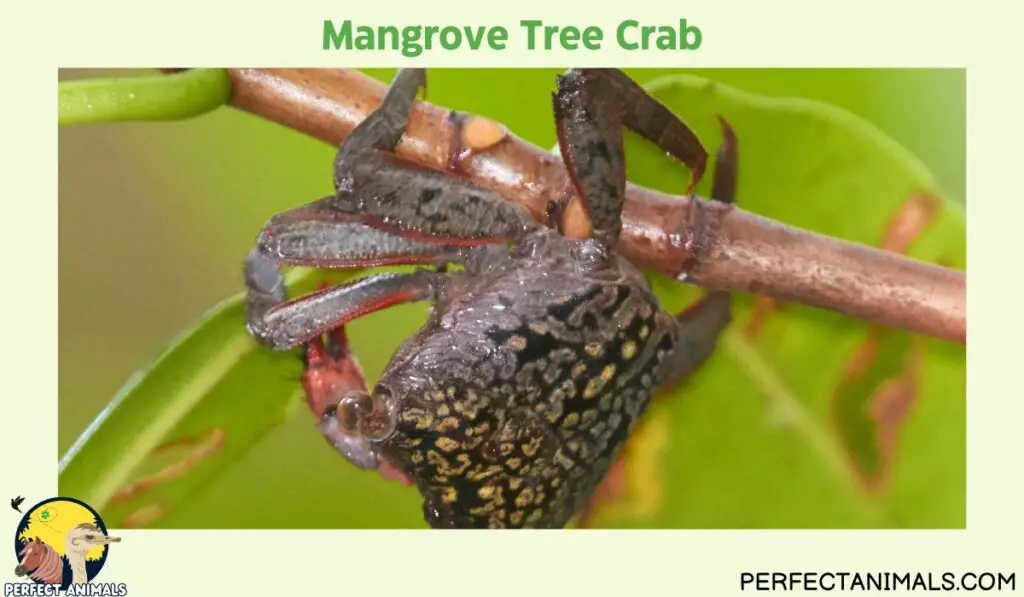
Mangrove tree crabs play an important role in the mangrove ecosystem.
They feed on leaves and clean up leaf litter, all while avoiding bird predators with their quick reflexes.
The crabs can climb down mangrove trunks to soak up seawater during high tide.
While kayaking through Florida’s mangroves, keep an eye out for almost imperceptible mangrove tree crabs perched on branches or darting down roots into the water.
They play a crucial role in defining the uniqueness of this habitat.
Purple Marsh Crab
Hidden amongst the grasses and mud of Florida’s salt marshes are the shy purple marsh crabs.
Despite their name, the square-backed shells of these crabs are more brown or olive-green.
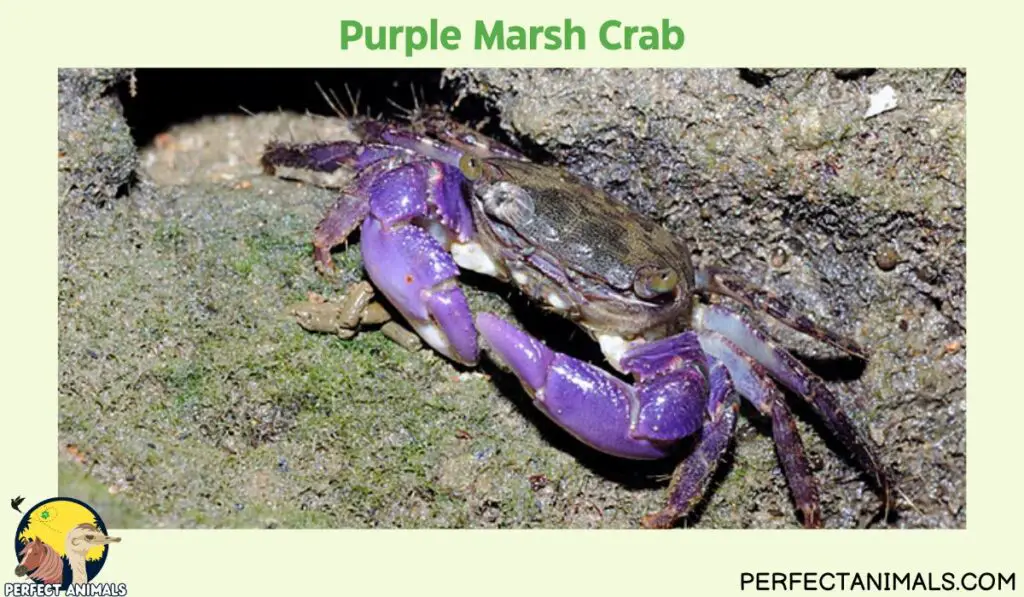
They use their stalked eyes to watch for predators while feeding on marsh vegetation.
Purple marsh crabs construct deep, interconnected burrows along marsh channels.
During high tide they emerge to feed and mate, performing an elaborate tapping ritual.
Females may produce up to 13,000 eggs in a lifetime.
Though elusive, these burrowing crabs help maintain the fragile balance of Florida’s salty marsh ecosystems.
You May Also Like – Do Fish Have Blood?
Calico Crabs in Florida
Common in Florida’s shallow coastal waters is the delightfully named calico crab.
These walking crabs have 3-inch carapaces splashed with vivid red and white spots, resembling the fabric they’re named for.
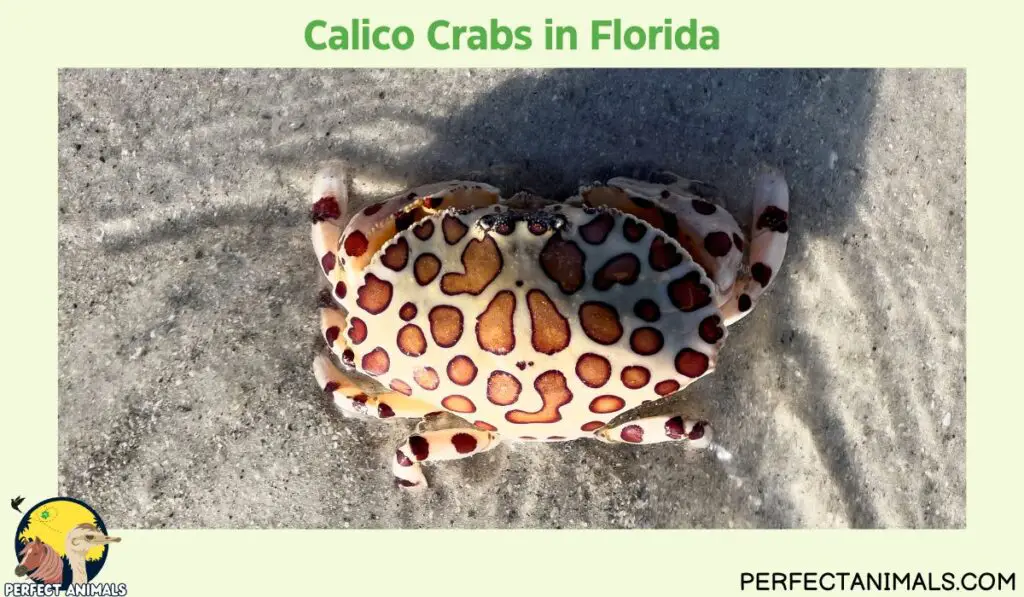
Their splotchy pattern helps them camouflage against the seafloor as they scavenge decaying plants and animals.
Calico crabs are sometimes found carrying sea anemones on their shells.
This symbiotic pairing benefits both – the anemone gets transported to food scraps while its stinging tentacles protect the crab.
This creative survival strategy is just one example of the unique adaptations of Florida’s diverse coastal crabs.
What Crabs Can You Not Eat?
While the variety of edible crabs in Florida is plentiful, some species are unsafe or unappetizing for human consumption.
Horseshoe crabs, for example, have toxic eggs and are better admired for their prehistoric appearance than eaten.
Hermit crabs and their shells may contain bacteria, parasites, or toxins from their scavenging lifestyle, making them unsuitable table fares.
Smaller crabs like fiddlers contain little meat and are more useful as bait. Their meat also tends to be unpalatable.
And the boxing claws of aptly named box crabs can deliver a nasty pinch, deterring most diners.
Certain masked crabs found in Florida’s imported Asian seafood may even be toxic if consumed.
It’s important to educate yourself on which crabs are suited for eating and which are best left alone.
While not all crabs are created equal when it comes to culinary quality, they all play important roles in Florida’s diverse marine ecosystems.
So admire the inedible species from afar, and sustainably enjoy the delectable ones on your dinner plate.
You May Also Like – Octopus Eyes
Final Thoughts
Florida’s abundance of crab species is a testament to the diversity of its coastal habitats.
From the tidal marshes where fiddlers scurry to the dark ocean depths where golden crabs lurk, crustaceans thrive in every ecological niche.
While not all crabs are safe or ideal for eating, they each play irreplaceable roles in their ecosystems.
Understanding and sustaining these unique crabs and their habitats ensures that Florida’s next generation of beachgoers can make their childhood memories of skittering ghost crabs and hermit crab shells.
Whether it’s spotting a camouflaged spider crab or cracking open fresh stone crab claws, encounters with Florida crabs are part of what makes the state magical.
The diversity found in a single sandy shoreline or grassy marsh rivals that of tropical coral reefs.
Each crab species represents a remarkable story of adaptation and survival.
The state’s abundance of magnificent crabs is just one chapter in that story.
With increased appreciation and stewardship, the tale of Florida’s spectacular coasts can continue to be told for generations to come.
FAQs
When is blue crab season in Florida?
The blue crab season in Florida runs year-round, with no closed season.
When is stone crab season in Florida?
The regulated stone crab season in Florida is from October 15 to May 15 each year.
Is it illegal to catch fiddler crabs in Florida?
No, it is legal to recreationally catch fiddler crabs by hand or with a dip net in Florida without a fishing license. There are no bag or size limits.
Resources – (for further reading)
National Wildlife Federation – Blue Crab,
Florida Fish and Wildlife Conservation Commission – Stone Crabs
Britannica – Fiddler crab | Mangrove, Burrowing & Behavior
Wikipedia – Atlantic ghost crab, Mangrove crab
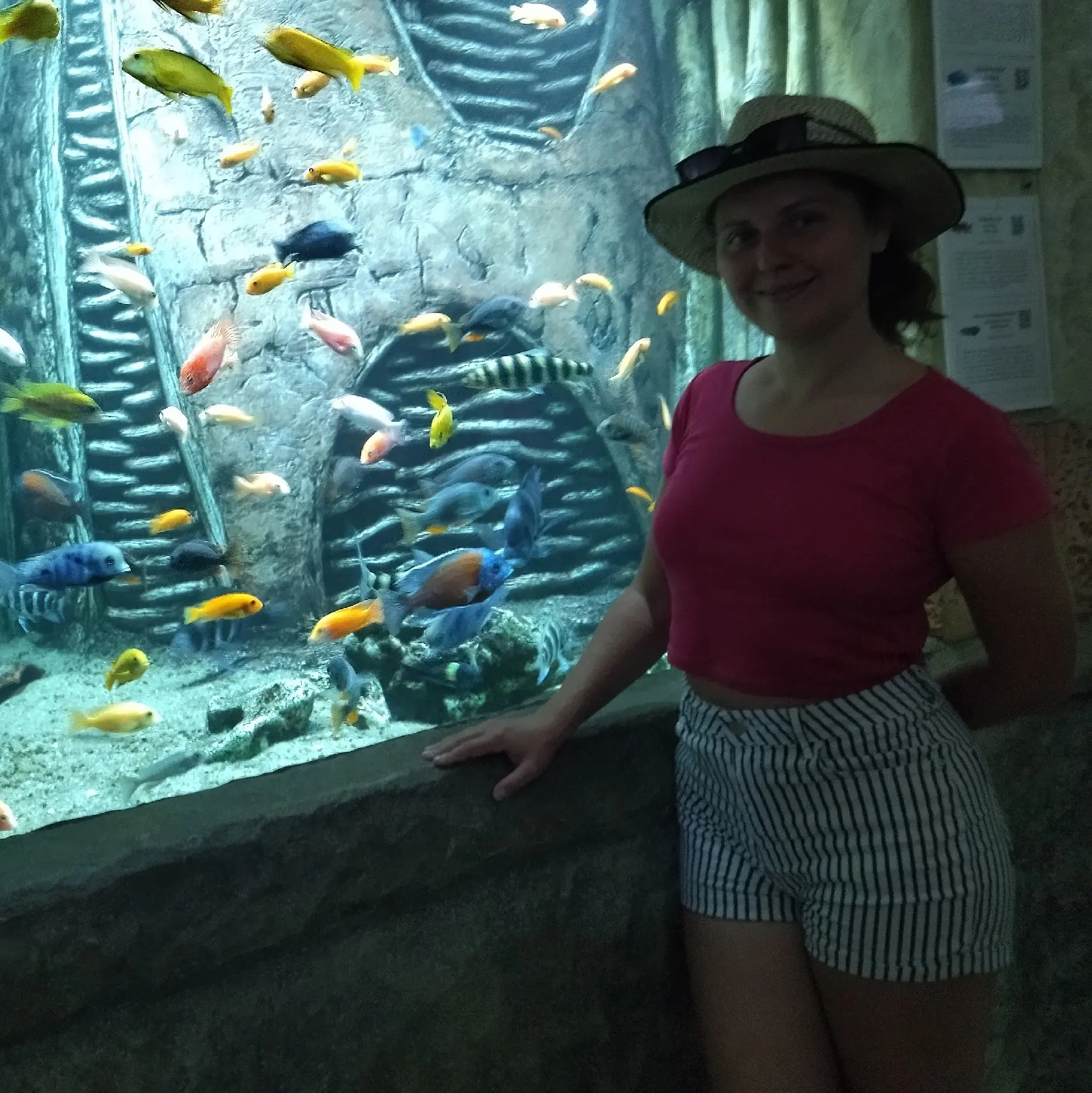
Sofi has worked as an educator at the Miami Seaquarium, where she conducted educational programs about marine life. In her free time, she contributes to our platform, sharing her passion for marine ecosystems and their conservation.
